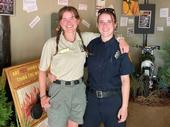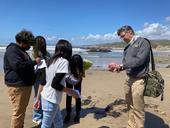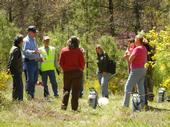- Author: Mike Hsu

Planning brochure for pets, livestock fills crucial need as fires an increasing threat
With the McKinney Fire creeping closer to Yreka in the summer of 2022, Emily Jackson and her mother potentially faced the enormous task of getting all their goats, chickens, dogs and cats to safety – while Emily's father and twin sister Lindsay were away fighting the fires.
Fortunately, Emily and Lindsay had gained crucial knowledge about evacuating animals through a 4-H service-learning project they helped lead in 2018. A group of eight 4-H youths, ages 14 to 18, had created a “Pet Emergency Evacuation Plan” (PEEP) brochure, aimed at educating their...
- Author: Saoimanu Sope

Ibrahim Yaaseen, member of the Palos Verdes Peninsula (PVP) 4-H club, grabs a hard hat and places it on top of his head. He then reaches for a bright orange safety vest and goggles to complete his safety gear outfit before joining the rest of his club members who are dressed the same.
The 4-H Youth Development Program of Los Angeles is already thinking about the future of water management and turned to the West Basin Municipal Water District in El Segundo to gain a deeper understanding of the precious resource we often take for granted.
The University of California 4-H Youth...
- Author: Pamela Kan-Rice

“I found so many things; I found a hermit crab, a starfish, a sea anemone,” exclaimed a Cherryland Elementary School student, his voice trailing off as he ventured back to the tide pools to explore more. The fifth grader from Hayward was participating in a 4-H Water Wizards course during a UC Cooperative Extension-sponsored field trip to Pescadero State Beach in San Mateo County.
In May, University of California Cooperative Extension bused 120 fifth and sixth graders from Hayward's Cherryland Elementary School – where the student population is 86% Hispanic and 6% Black – to UC Elkus Ranch...
- Author: Jeannette E. Warnert

Although individual extreme weather events cannot yet be reliably linked to global climate change, the warming planet may be contributing to recent weather disasters in California. Across the state, 129 million trees died as a result of the drought of 2011-2016, many of them in the Sierra Nevada. Last fall, the worst wildfires in the state's history whipped through wildland areas and neighborhoods, and then were followed by a January deluge and deadly mudslide.
Climate change is also impacting agriculture. The winter chill that farmers rely on to re-boot cherry, pistachio, walnut and other important fruit and nut crops has been curbed by unseasonably warm nighttime temperatures. Sustained summertime heat waves are damaging crops...



